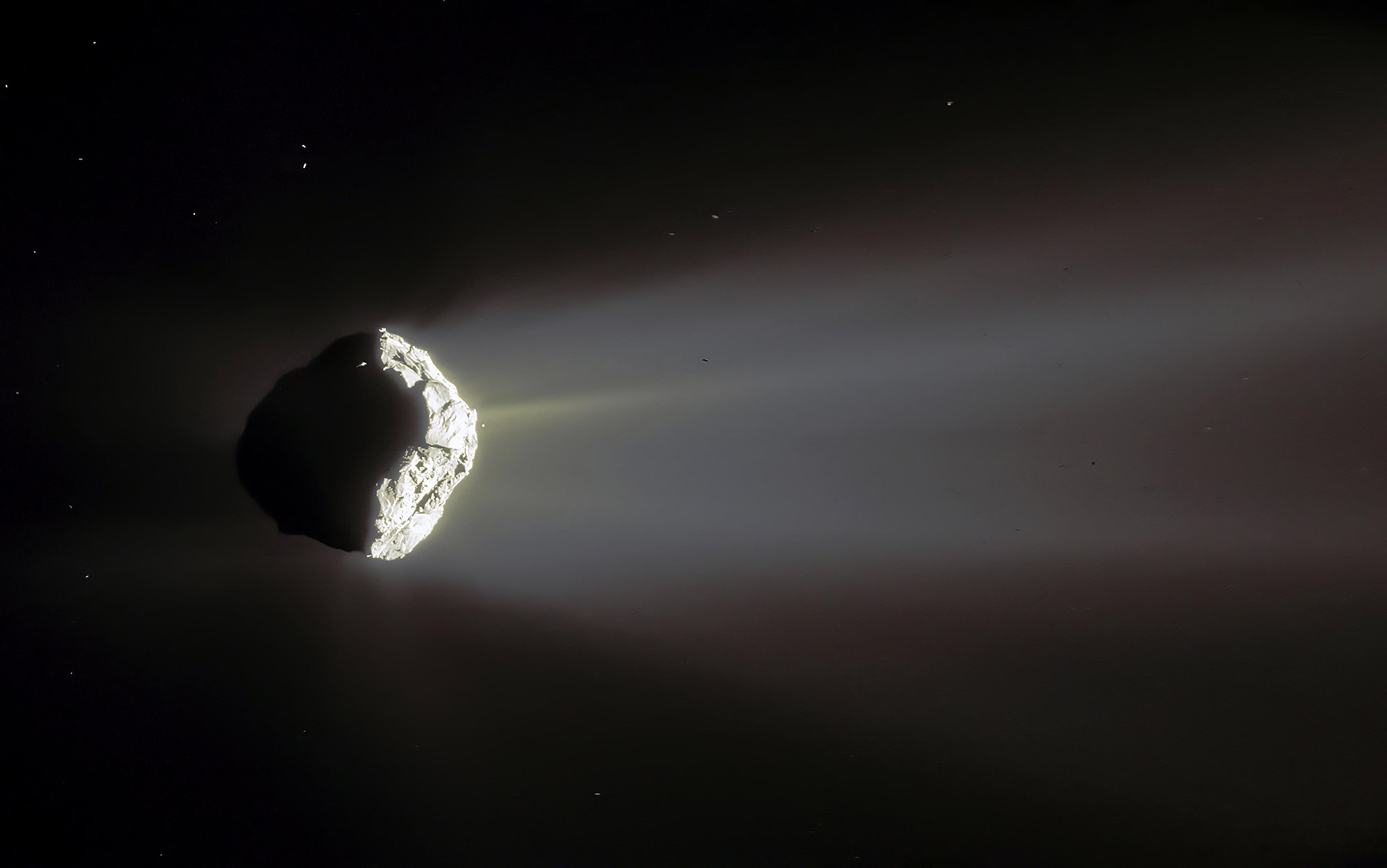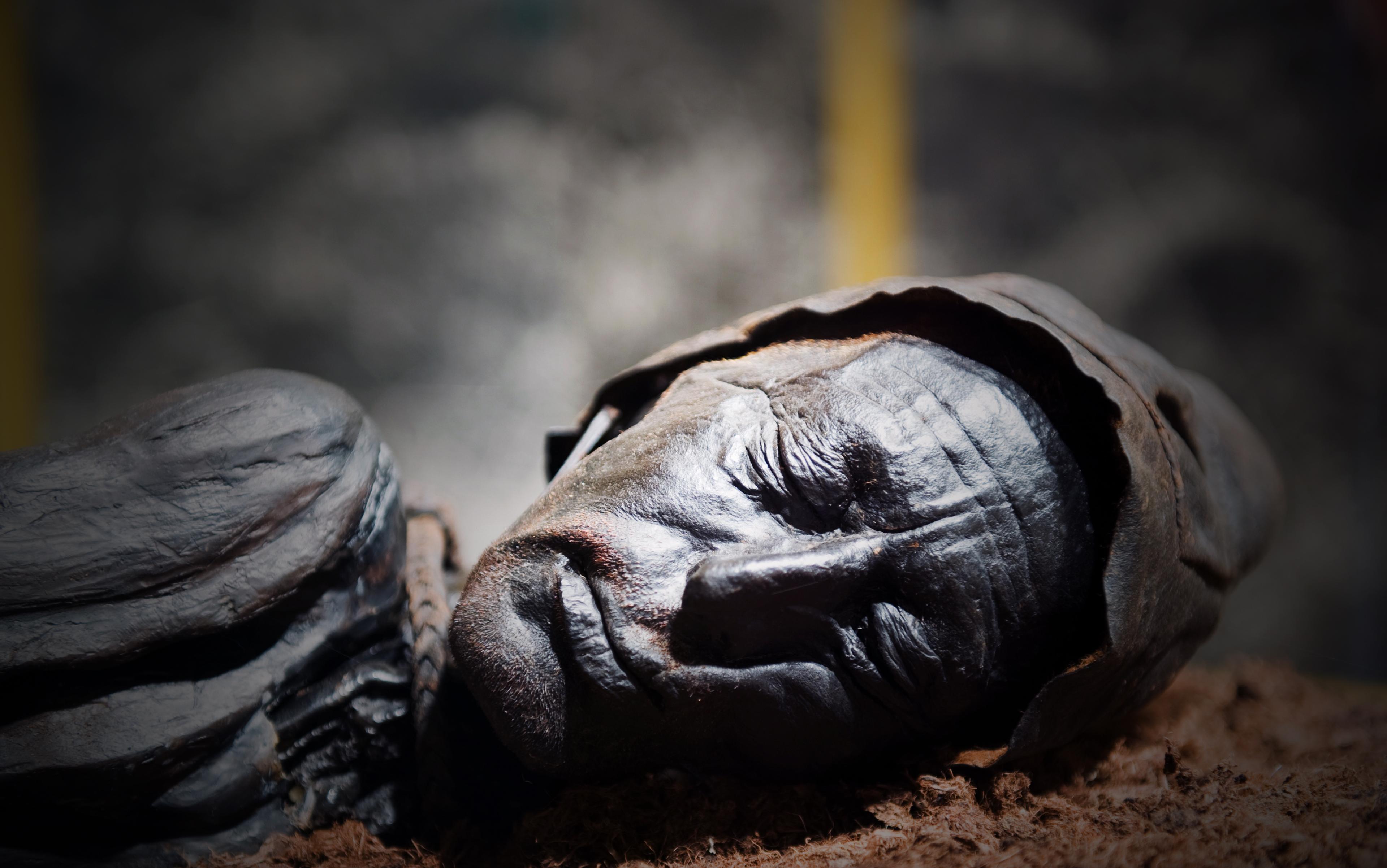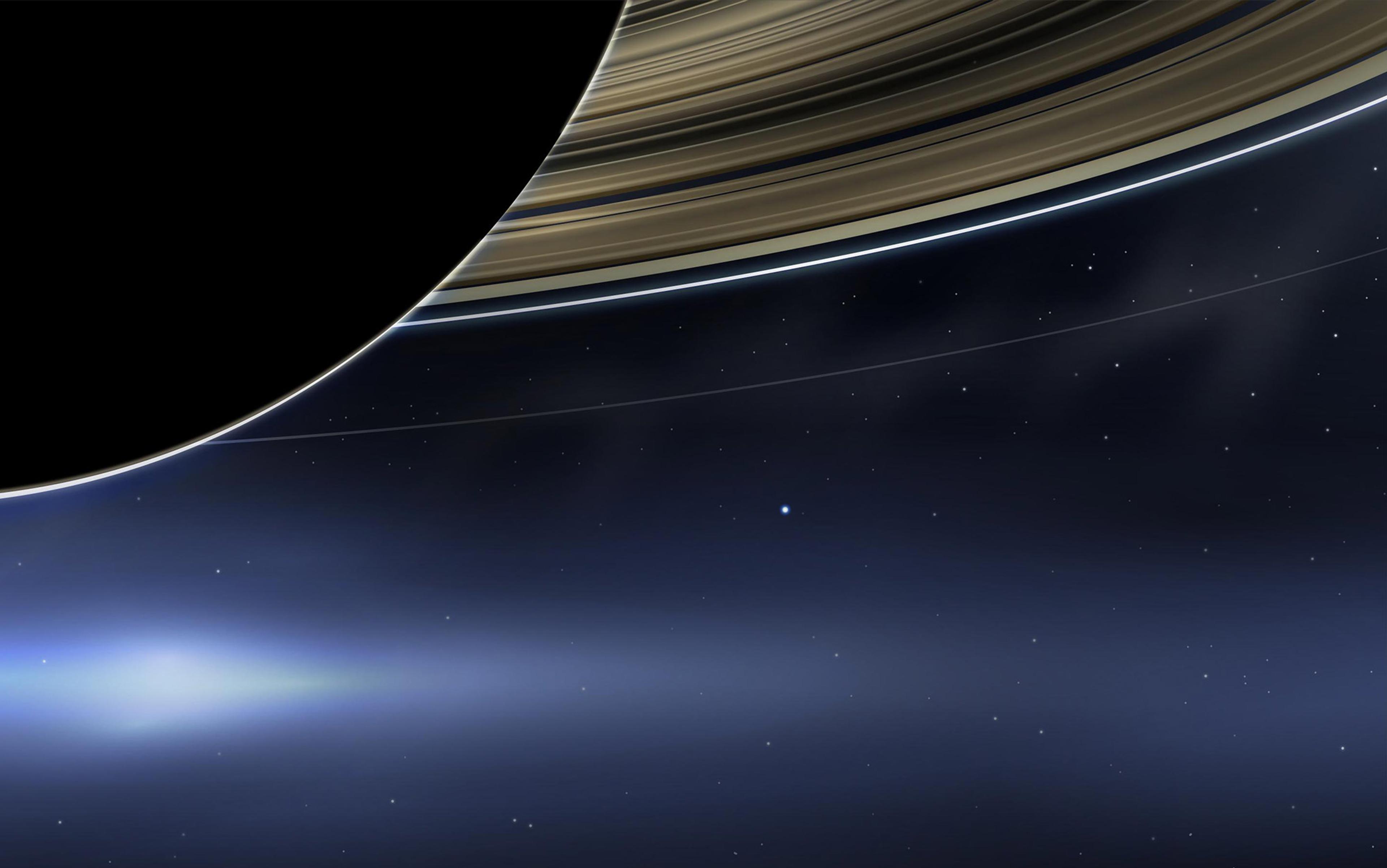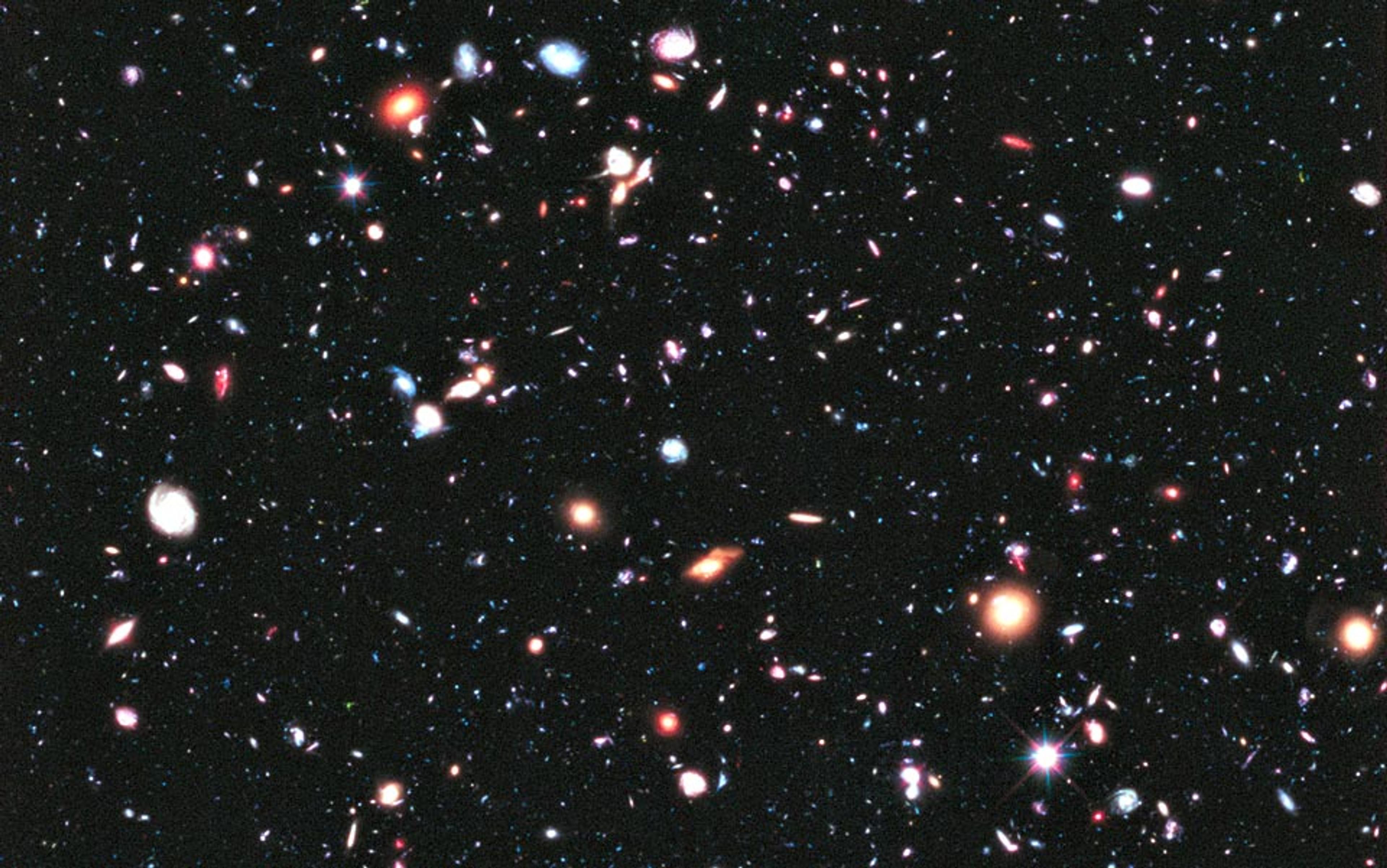When one looks at the long sweep of Big History – a panoramic view of the history of everything from the unfolding of the Universe to the evolution of life to the small human story, with its dazzling technology and bloody wars – a question emerges: do we see regularities in the unfolding of the past, or is history all disorganised confusion – just ‘one damn thing after another’? Are there laws that control the unfolding of history?
Beginning with Isaac Newton in the 17th century, scientists have discovered that there are unbreakable mathematical laws governing the motions of objects and all transformations of energy. This discovery suggested that beneath the seemingly capricious events of daily life there might be an underlying order, and that it might even be possible to discover fundamental laws of history itself. But the search for these hoped-for laws of history has not been very successful.
Planets orbiting stars and glaciers creeping down mountainsides are the kinds of things in the history of the regimes (or separate domains) of the Cosmos and Earth that do obey the mathematical laws of physics, and their motions can be calculated. At some point in Big History, however, something different appeared, making it seem very unlikely that well-formulated laws of human history, especially mathematical ones, can be discovered, or that they even exist. What changed was the appearance of life, in which each cell or each multicellular organism is an independent agent, competing with other agents – seeking to acquire energy and nourishment, and passing its traits on to its offspring if it is successful.
The appearance of living agents took our planet beyond the realm of the phases for which physicists can discover natural laws – plasmas, gases, liquids and solids – and brought into being matter organised in far more complex ways. This, I would suggest, was also the beginning of the regimes of Big History – Life and Humanity – for which natural laws simply might not exist. If this is correct, and there are no deterministic laws governing the history of living organisms or human beings, is there any other way to make sense out of history? Can we find, for example, regularities or patterns in the unfolding of history?
In his provocative book Time’s Arrow, Time’s Cycle (1987), Steven Jay Gould argued that there has long been a difference in views of the past between those who saw history as directional and those who considered it to be cyclical. He argued that the conflict between those two views not only influenced how scholars interpreted human history but was also a central intellectual conflict among the early geologists who developed our first serious understanding of Earth.
Time’s arrow versus time’s cycle was a reasonable dichotomy when geologists and historians had only words to describe the past. The ‘decline of Rome’ and the ‘rise and fall of empires’ were provocative descriptions of the past, suggesting arrows and cycles. Now, however, especially in geology, we have a great richness of quantitative data sets – numerical measures of how things have changed in Earth’s past. In studying those plots of history, I find it hard any longer to see the arrow/cycle dichotomy as fundamental.
The problem is one of time scales. If we look at the temperature history of Earth’s surface, we see trends or cycles depending on the time interval we choose. For the past 10,000 years, temperature has been remarkably constant, but taken over the past million years, the temperature plot is cyclical with glacial and interglacial times alternating over 100,000-year cycles. On shorter or longer time scales, there are cooling trends and warming trends.
Completely unexpectedly, contingency can strike, and we can fall off a ladder, or fall in love, and nothing will ever be the same again
As I look at the way history has unfolded across all the regimes of Big History, I think I see a different dichotomy. On the one hand, I see continuities, made up of trends and cycles, combined in various ways at various time scales. On the other hand, there are contingencies – rare events that make significant changes in history that could not have been predicted very far in advance.
Contingencies are everywhere. In our personal lives, we can pass through long periods of continuity, going to work and returning home every day in a cyclical pattern, and meanwhile gradually getting older and perhaps wiser, which are trends. And then, completely unexpectedly, contingency can strike, and we can fall off a ladder, or fall in love, and nothing will ever be the same again. Human history is riddled with contingency, and this is part of what makes it impossible to find laws controlling history. Contingency is particularly dramatic in warfare, with the outcomes of battles turning on such unpredictable circumstances as the way the wind was blowing or the finding of accidentally lost orders.
Although contingency surrounds us and we can often recognise it, defining contingency turns out to be quite difficult. I have not yet found a satisfactory definition or been able to construct one. My current thinking is that for an event to be considered contingent, it needs to be (1) rare, (2) unpredictable, and (3) significant. But each of those qualities involves ambiguities. And when we try to understand what causes contingency, the situation in the two inanimate regimes of Big History – Cosmos and Earth – seems to be completely different from the situation in the Life and Humanity regimes.
Let us first consider contingency in the Cosmos and Earth regimes, taking the impact that finished off the dinosaurs as an example. Then we will look at contingency in the Life and Humanity regimes, with the Spanish Armada as an example. And, finally, let’s think about the astonishing contingency that lies behind the presence here on Earth of each one of us. In each case we will see to what extent the rare-unpredictable-significant criteria are applicable.
For the two inanimate regimes, the ‘rare’ and ‘significant’ aspects of contingency are not difficult to understand. In the power-law distribution of sizes for many natural objects and events, like the diameters of impacting objects and the magnitudes of earthquakes, larger objects and events are rare compared with smaller ones. Larger events are significant over broader areas and touch more people. It’s the ‘unpredictable’ aspect of contingency that is most interesting.
It once looked to scientists as if everything that happens in the Universe is completely controlled by the deterministic, mathematical laws of nature. These laws seemed to be fully predictive. In the early 19th century, the French mathematician Pierre-Simon Laplace argued that if a sufficient intellect – a super-super-computer, we might say – were given detailed information about the position and velocity of every particle at some time in the past, it could predict the future with complete accuracy. If this view were correct and applied to all the atoms that make up a human being, it would imply that we have no free will.
But that was before the 20th-century discovery of the limits to predictability. We now understand that even with inanimate materials that clearly obey the mathematical laws of nature, in certain situations there are complications that make the future completely unpredictable. For most scientists it was a real surprise to find out that a fully deterministic system might not be predictable. Here are some examples, ordered from larger to smaller scale.
In a solar system with three or more objects, the equations of motion cannot generally be solved, although the planetary motions themselves can be traced out with computer-intensive calculations. When this is done, it turns out that tiny differences in the initial position and velocity of a planet lead to significant differences in its position and velocity after tens of millions of years. This means that over the long haul, planetary motions are unpredictable, a situation known as orbital chaos or deterministic chaos.
The tiniest difference in starting condition produces completely different results down the line
Fracturing of solids such as rocks is unpredictable in detail, depending sensitively on microcracks and on flaws or dislocations at the atomic scale. Some tiny fractures will cascade into giant earthquakes but most do not. This is what makes it apparently impossible to predict earthquakes in a precise way – to say, for example, ‘there will be a magnitude such-and-such earthquake at a specific time and place’ – although probabilistic estimates of the likelihood of a given-size earthquake in a general region over a rough time frame are indeed made.
Turbulence in fluids is also chaotic, and this places weather, storms and ocean currents in the category of phenomena that are unpredictable in detail. Belousov-Zhabotinsky reactions are a class of chemical phenomenon in which circular or spiral patterns appear in a petri dish, growing and interacting in a chaotic, unpredictable fashion.
Finally, there is the logistic equation, a very simple and easily derived mathematical formula. The logistic equation contains a squared term, and when it is applied iteratively, with the result of each calculation fed back as the starting point of the next calculation, the results are chaotic in the sense that the tiniest difference in starting condition produces completely different results down the line. Originally discovered in the 1970s by the biologist Robert May when he was trying to predict the number of individuals of a species over many generations, given different rates of reproduction, this has become a classic example of deterministic chaos and mathematical unpredictability.
It thus seems clear that, despite the rigorous mathematical laws of nature, many aspects of our human situation, from the scale of the solar system down to the scale of a petri dish and smaller, are fundamentally unpredictable.
Contingencies have impressed me strongly because of the work I’ve done on the extraterrestrial impact that caused the extinction of the dinosaurs. Let us look at the character of that event as an example of contingency in the Cosmos and Earth regimes.
We humans exist only because of the extinction of the dinosaurs. Dinosaurs were the dominant large animals on Earth from about 200 million years ago until their disappearance 66 million years ago. Mammals were around for most or all of that time but never got very large or very diverse until the dinosaurian competition was removed. After that cataclysmic event, mammals began a rapid diversification, and some lineages increased enormously in size, filling the large-animal niches formerly occupied by dinosaurs.
It is hard to imagine that an outside observer, dropping in to visit Earth 150 or 75 million years ago, could ever have predicted that mammals, including large and intelligent ones, would ever become the dominant animals on this planet, and that dinosaurs would be represented only by their descendants – the birds, most of them quite small in size. The dominance of mammals was the result of a contingent rerouting of major pathways in life history.
The evidence now strongly indicates that the dinosaur extinction was the result of the contingent impact of an asteroid or a comet that created the Chicxulub Crater, 110 miles in diameter, now buried almost a mile down beneath younger sediments, under the surface of the Yucatán Peninsula of Mexico. It is also possible that the enormous volcanic eruptions of the Deccan basalts in India at about the same time might have played some role in the extinction as well.
The impact event meets all of my proposed criteria for contingency – impacts of that size are very rare, the Chicxulub impact was unpredictable over the long term because of orbital chaos, and it was very significant, completely changing the course of evolution. Let us think about each of those three features of the Chicxulub impact.
First of all, impacts making craters the size of Chicxulub have been extremely rare since very early in Earth’s history. Chicxulub, 66 million years old and 110 miles in diameter, is the largest known crater formed in the past 540 million years, during the Phanerozoic – the time for which we have good fossil control – and indeed for a much longer time than that. The only larger craters preserved on Earth are much older – Sudbury in Canada, 160 miles in diameter and 1,850 million years old, and Vredefort in South Africa, 200 miles in diameter and about 2,025 million years old.
When we consider the size of the solar system and the paucity of potential impactors with diameters of several miles that might make Chicxulub-scale craters, it is understandable that these have been rare events in the past 3 or 4 billion years (although common when Earth was first assembling). Most asteroids (about 99 per cent) and a third of the far less abundant visible comets never come closer to the Sun than the orbit of Earth and, thus, have zero chance of hitting our planet.
Even for Earth-crossers, the chances of hitting Earth are extremely small, and here’s a way to see why. Make a circle with your left thumb and forefinger to represent the orbit of the Earth around the Sun – an imaginary dot in the centre of the circle of your thumb and forefinger. Then link it with a circle of your right thumb and forefinger, representing the orbit of a killer asteroid. Now imagine the circle of your left hand changing from fingers to a filament 1/100 the diameter of a human hair, representing the path swept out by Earth. And imagine your right-hand fingers shrinking to a filament 1,000 times thinner than the left-hand one, representing the path of the asteroid. Only if those hairs pass through each other is there any chance of an impact, and since impactor orbits move around in time, there is a chance of an impact only for a short time, before the hairs no longer intersect. And even if the orbits do intersect briefly, there is only a tiny window of time, a few minutes at most, in which both impactor and Earth are at the intersection point at the same time – otherwise, no impact. For any given asteroid or comet, the chance of impact is extremely small.
Even if you knew the positions of all the solar system bodies early in its history and had unlimited computing power, you could not possibly calculate their positions today
If there are vast numbers of potential impactors, as there are for tiny objects the size of sand grains, then statistically there will be many impacts. This is why on most clear, dark nights you can see an occasional meteor, or shooting star, which is a sand-size meteorite burning up by friction as it enters Earth’s atmosphere at high velocity. But for objects large enough to cause an extinction, statistically, impacts will be extremely rare.
Was the impact unpredictable? Here we meet a fascinating paradox. On the one hand, nothing can be more exactly calculated than orbital motions in the solar system, which are fully determined by the laws of physics. That is why astronomers can predict precisely when and where each eclipse will be visible on Earth, centuries in advance, and why spacecraft can be sent on trajectories to meet up with planets years later.
On the other hand, there are two factors that can confound these predictions. If our potential impactor is a comet, with pockets of ice in a matrix of rocks and dirt, the heat when the comet gets close to the Sun will vaporise these ice pockets, creating little jets of steam that will deviate the comet’s trajectory in small but unpredictable ways.
More interestingly, it is now understood that orbits in a system with more than two bodies, like our solar system, are inherently unpredictable over the long term. This is called deterministic chaos, and it means that even if you knew extremely well the positions and motions of all the solar system bodies early in its history and had unlimited computing power, you could not possibly calculate the positions and motions today. So there is a subtle but important distinction reflected in the term deterministic chaos – the motions of an orbiting body are fully determined by the laws of physics, but they are unpredictable because we can never know the starting conditions well enough. Over the long term, the tiniest differences in the original positions and motions produce huge variations in today’s solar system – a state called ‘sensitive dependence on initial conditions’. In that sense, the dinosaur-killing impact was unpredictable.
When we ask whether impacts are significant, we run into another question of scale. It is hard to deny that an impact such as Chicxulub, removing about half of the genera of animals on Earth including the large dinosaurs, and bringing a group of previously small animals – the mammals – into dominance, was significant by any measure. Smaller impacts are significant for anything living at ground zero – for example, the meteor that burned up over Chelyabinsk in Russia on 15 February 2013 – but not at the scale of the entire planet. Still smaller impacts, such as meteor streaks several times a night, must be insignificant by any measure.
When we leave the inanimate world of the Cosmos and Earth regimes and cross the threshold to the living organisms of the Life and Humanity regimes, contingency becomes both more pervasive and more difficult to understand. Things are now much more complicated because each organism is an ‘agent’, selected by nature to be good at obtaining nourishment and at reproducing. Each agent is competing with others of its kind to eat and to avoid being eaten. As evolution progresses, new approaches to this double task emerge, the opportunities for contingency are many, and the result is the life history that did happen.
Examples are everywhere. The evolution of eyes in predatory trilobites about 540 million years ago is thought to have triggered the evolution of hard, protective shells in many kinds of prey species, which marked the beginning of the abundant fossil record. The appearance of a new and very virulent bacterium gave rise to the Black Death that completely rerouted the history of the European Middle Ages.
As a further example, I like to think about the fact that we have two arms and two legs. Few animals other than birds walk on two legs, and it took a major evolutionary development, from Ardipithecus to Australopithecus to Homo, for us to be able to walk on two of our four limbs, freeing the other two (the hands) to learn to make and use tools, which is one of the key aspects of the human situation. Our four limbs are descended from the four fins of lobe-finned fishes such as Tiktaalik and Acanthostega, around 370 million years ago, which evolved into the first land animals. Thinking in the counterfactual mode, suppose that those fish had had six fins. Might land animals ever since have had six limbs too, making it easy for them to walk on four legs and still have two arms free to make tools? Could human-like intelligence and toolmaking have appeared much earlier with Earth’s intelligent animals looking something like centaurs?
Think how different the 20th century would have been if Hitler had stayed with his early career as an artist
With the appearance of intelligence, language and tools that marked the beginning of the Humanity regime, contingency became even more widespread. This effect is not easily quantified, but it is interesting to think about. For example, in living organisms other than humans, each individual is an experiment. If the individual’s genes give it a survival and reproductive advantage, they are likely to be passed on. The time for each generation to succeed the previous one sets a limit on how fast genetic contingencies can pile up.
But our brains allow us to do thought experiments about possible futures – for example, should I be a musician, a scientist or a bank robber when I grow up? Each of us can run many such thought experiments during our lifetime, and deciding which mental experiment to carry out in real life allows enormous contingencies to direct history down any one of myriad possible paths. Think how different the 20th century would have been if Adolf Hitler had stayed with his early career as an artist.
The neurophysiologist William Calvin at the University of Washington in Seattle has suggested that a similar process of constructing multiple scenarios and choosing between them takes place constantly in the human brain. According to Calvin, even in a fast-paced conversation the brain generates many possibilities for what to say next and then chooses which one to say, perhaps on the basis of previous experience in similar situations. Brilliantly creative ideas and things one will always regret having said arise in this way, through the brain’s ability to generate lots of possible scenarios. Systems that function in this way, by generating multiple possibilities and choosing among them, have been called Darwin machines. Among them, both evolution and the human brain seem to have been major contributors to the enormously contingent path of life history and human history.
Contingency is everywhere in human history. As a geologist, coming from a field where it is much less obvious, I find contingency very interesting. David Christian, the founder of Big History, once told me that for him, coming from the humanities, contingencies are so overwhelmingly abundant that they don’t interest him very much; he prefers to try to identify continuities. Just to give the flavour of contingency in human history, let’s look at a case from the history of Spain and England in which geology is also involved. You will be able to find equally dramatic examples of contingency in the history of any place that interests you.
In 1588, Spain was the strongest power in Europe and controlled a great empire in both the Old World and New World with huge shipments of silver coming annually from Peru and Mexico. This enormous income was largely used to prosecute religious wars against the Protestants. Spain’s powerful king, Philip II, who was particularly hostile to Protestant England, built a great fleet – the Spanish Armada – to cross the English Channel and bring the English back to Catholicism by force.
What contingencies went into Philip’s plan? Without Philip’s upbringing as a fervent Catholic, there would have been no motivation for an invasion of England. In addition, there would have been no need to build an Armada if there had not been an English Channel. In the 16th century, Spanish armies were the finest in Europe; no soldiers anywhere could stand up to a Spanish tercio. If England had been a peninsula rather than an island, Philip’s army could have simply marched into England and taken it over. But there is an English Channel, and that natural moat has protected England from medieval times until the Second World War.
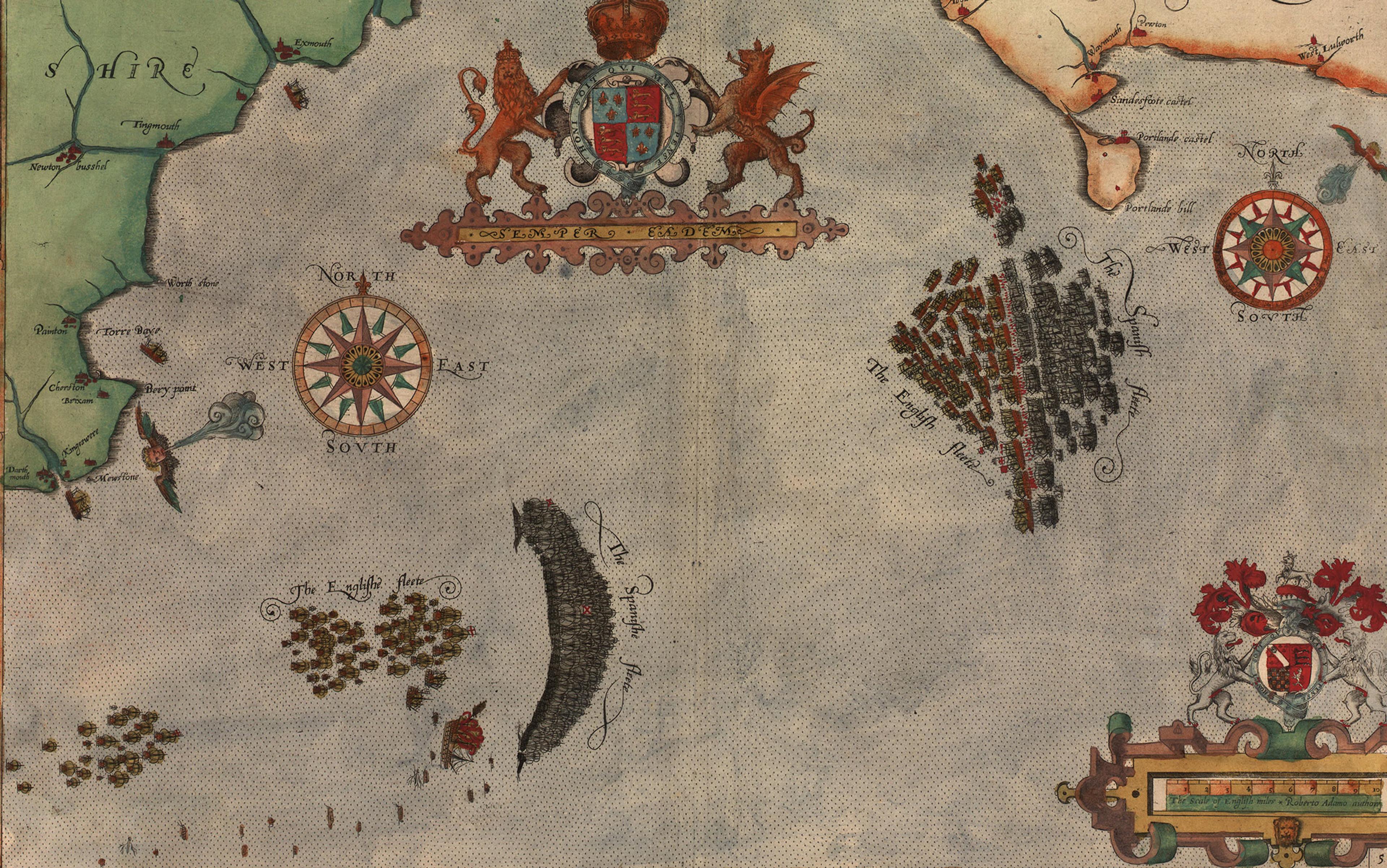
Detail from the 1590 map Expeditionis Hispanorum in Angliam by Robert Adams. Courtesy NASA
A geologist, of course, asks why the English Channel is there, and the answer based on recent research is fascinating. At some time during the Pleistocene Ice Age, there was still a highland connecting England and France where the Straits of Dover now lie. Sea level was about 300 feet lower than today because of all the water locked up in ice in Canada and in other great ice sheets. Glaciers covered much of Scandinavia and Britain. As they retreated, a large meltwater lake formed, trapped between the ice sheet to the north and the Dover highland, which was in fact an anticline – an upfold of the sedimentary rocks. At some point, the lake level rose to a height where it spilled over the Dover dam, catastrophically eroding a great channel during what geologists call a megaflood. This megaflood was proposed four decades ago, but only in 2007 was it fully confirmed, when a detailed survey of the floor of the English Channel revealed the presence of streamlined former islands, carved by the megaflood waters, just like ones known from the glacial megaflood channels of central Washington. This is hard science, suggesting that, had the last ice age been less icy, there might have been no English Channel, and Philip’s Armada would not have been necessary.
The way the wind was blowing that night had something to do with why England remained Protestant, and why the US was colonised by English, not Spanish, speakers
The Armada was to sail from Spain to Flanders in 1588 to pick up a Spanish army, which it would transport to England for the invasion, but miscommunications and misunderstandings – common contingencies in warfare – interfered with the plan. Thus the Armada found itself anchored in the English Channel off Calais, awaiting the army. One night, with the wind blowing in a favourable direction, the English set fire to some old ships and sent them into the closely packed fleet of Spanish ships. The Spanish captains quickly set sail and somehow all managed to avoid being struck and burned, but in the ensuing confusion the Armada was scattered and unable to pick up the army for the invasion of England. What with storms, English harassment and general chaos, many of the ships and their crews were lost. The surviving ships tried to sail all the way around the British Isles and back to Spain. A few made it home, but the chance to invade England was lost.
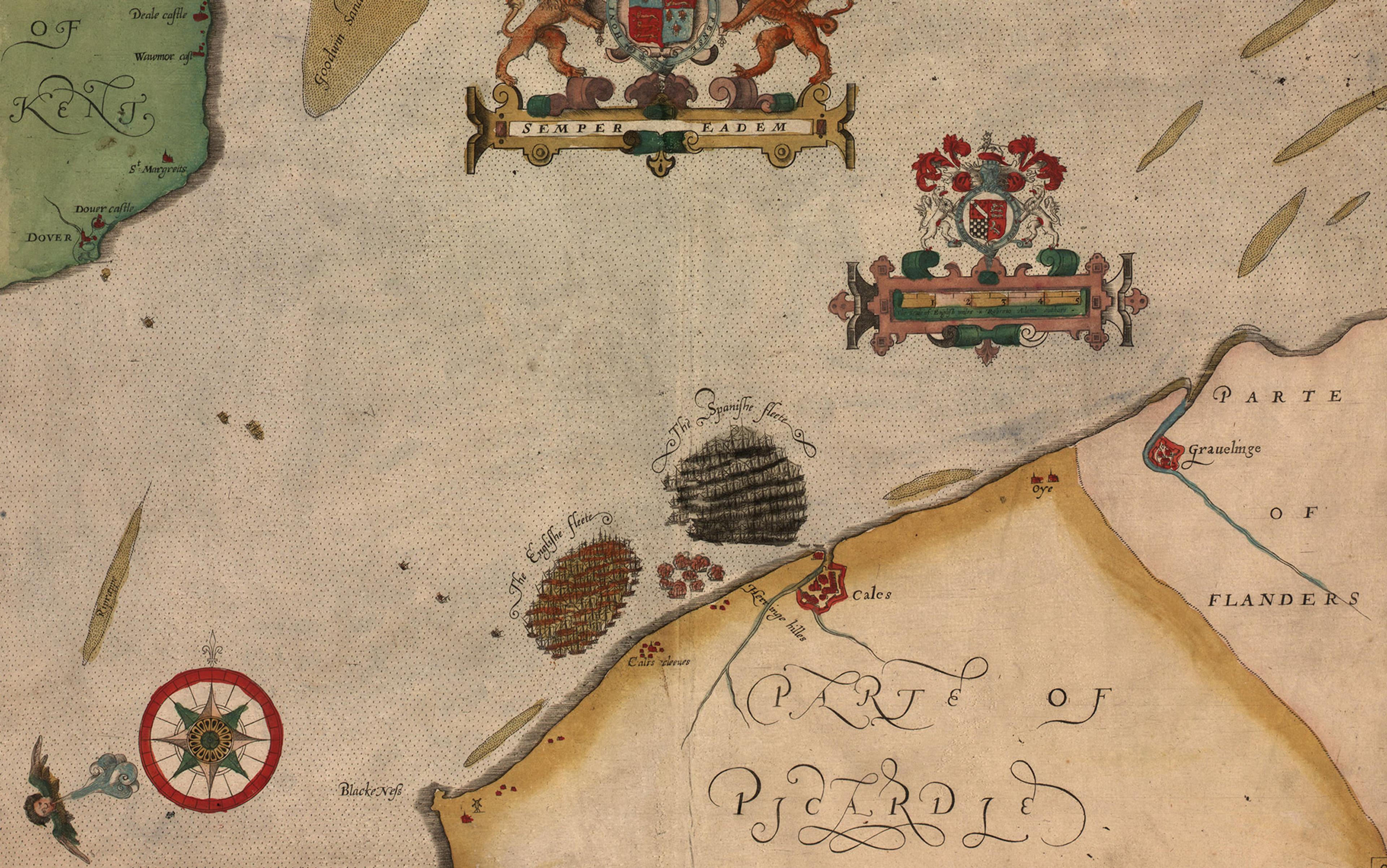
Detail from the 1590 map Expeditionis Hispanorum in Angliam by Robert Adams. Note the prevailing wind, bottom left, and the fireships between the fleets. Courtesy NASA
Perhaps we can conclude that a tiny geological contingency – the way the wind was blowing on a particular night – had something to do with why England remained Protestant, and why the United States was colonised by English speakers, not Spanish speakers. And yet it was only on that particular night that it mattered to history which way the wind was blowing; a chance event is evidently only significant if it occurs at what has been called a ‘critical juncture’.
Contingency is everywhere in human history. A contingent, catastrophic, geological event produced the channel that made Philip’s Armada necessary; the thinking of Martin Luther in Germany generated the Protestant Reformation that Philip was determined to reverse; the contingencies of Philip’s life, thought and beliefs led to the Armada being built; accidents of warfare kept the ships waiting to pick up his army; and contingent wind conditions allowed the English fireships to begin their destruction. But what was the chance that there would ever have been a Philip to set these events in motion? In our two final sections, let us look at the enormous contingency, the breathtakingly tiny odds, that Philip, or any one of us human beings, would ever have come to be.
We can recognise continuities in our lives – like the ageing trend from infancy to old age, and cycles such as day and night and the seasons. And yet we live our lives immersed in an ocean of contingency – accidents, the vagaries of illness or health, or a chance meeting that leads to conflict or friendship, or love. Even our existing at all is completely contingent and improbable to a degree that beggars belief. We can see this by looking at how Philip II came to exist and came to be king. And we can see it in the chance contingencies in each of our genealogies.
Philip II was king of Spain at the time of the Armada because of a remarkable set of contingencies a generation earlier. His father, the Emperor Charles V, was also king of Spain. Becoming king in 1516 and Holy Roman Emperor in 1519, Charles received a fabulous inheritance – an empire covering much of Europe and the newly discovered Americas. But a few years earlier no one could have predicted that he would ever inherit Spain or anything else. Charles’s Spanish kingdom came through his mother, Juana, third child of Ferdinand and Isabel, the patron of Columbus. The crown should have gone to Prince Juan, their only son, but he died at age 19 and his only child was stillborn. Next in line was daughter Isabel, but she died giving birth to her only child, who in turn died in infancy. Juana became queen and her son Charles became king only because of four premature deaths from natural causes. Even in an age when the mortality risk during childbirth was high, the rise of Charles would have been surprising. It was these contingencies that brought Charles to the Spanish throne at the peak of its power and his son Philip in turn.
Without the untimely death of my great-great-grandfather, there would never have been a California branch of our family, and I would not exist
Philip’s contingent kingship and the contingent fate of his Armada had enormous consequences for the unfolding of world history. Few people have significance at that level, but even the fact of our being here at all is highly contingent. Going back even one or two generations, the probability of any one of us ever being born would have been vanishingly small. Our mere existence meets the three requirements for contingency. Unless you have an identical twin, the birth of someone with exactly your genes was not only rare but unique as well; it was unpredictable; and it was significant at least at the level of family and friends. Each individual’s rarity and improbability are quantifiable in at least a rough way. What we learn by estimating our improbability can give us insights into some of the deepest questions we can ask.
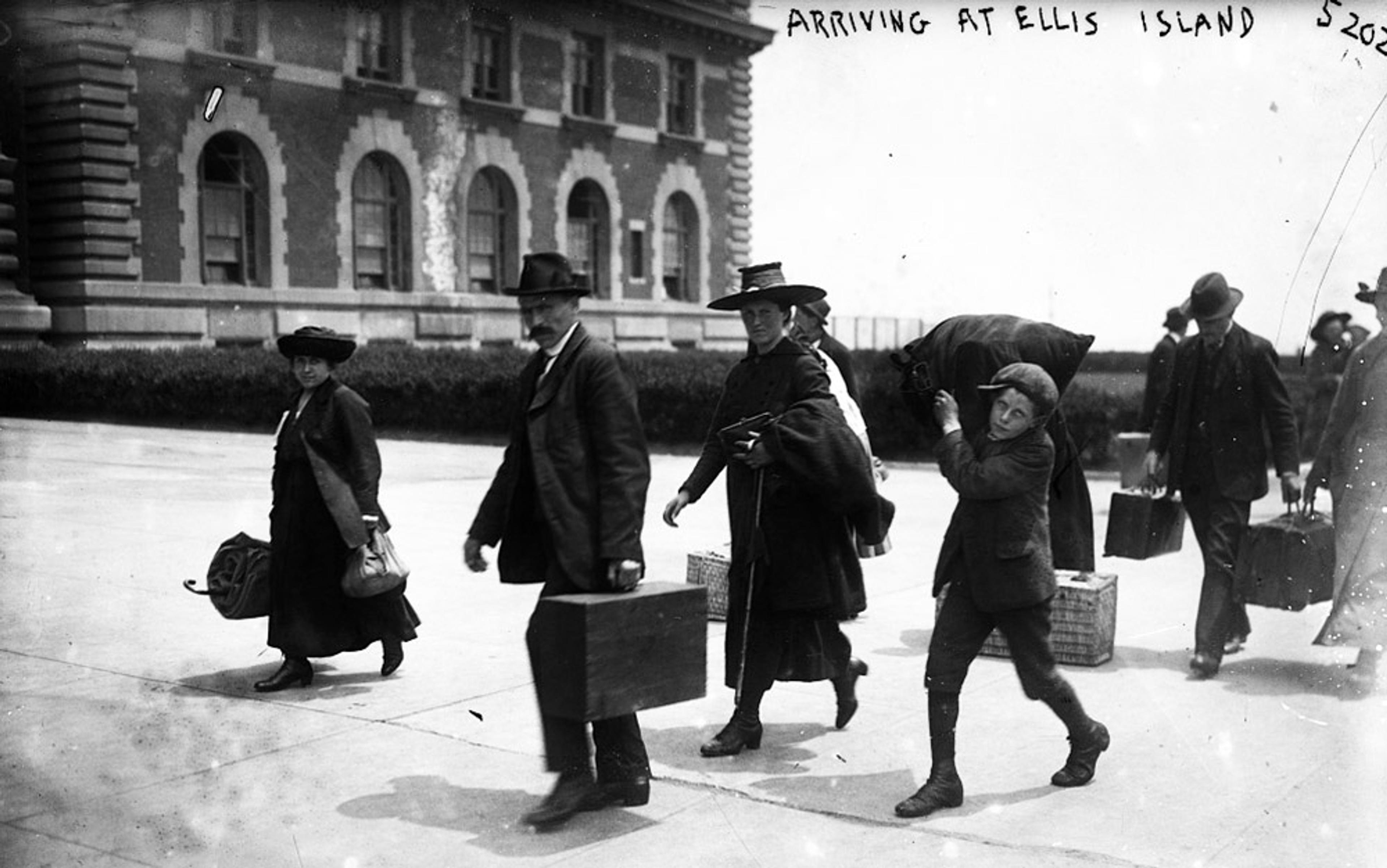
Immigrants arriving at Ellis Island. Courtesy Library of Congress
My great-grandfather, Luis Fernández Álvarez, emigrated from Spain to Cuba at age seven with his older brother, because their father had died in a fall from a balcony in Bilbao, and they had already lost their mother. Eventually, he ended up as a doctor in Hawaii and California. I feel bad every time I think of the untimely death of my great-great-grandfather, but I also realise that, without that contingent event, Luis would probably never have left Spain, there would never have been a California branch of our family, and I would not exist.
When I tell people about this, I sometimes hear the most remarkable stories of the contingencies that have allowed them to be here. Rudy Saltzer’s was one such story. He was a dear friend and a fine choral conductor; Rudy’s father was a soldier in the Russian army in the First World War. Having been awake all night as a sentry, he volunteered for a second night’s sentry duty to replace a sick friend and fell asleep – a capital offence. He was behind bars when a visiting officer passed by with the captain of the unit on a tour of inspection. The inspector noticed Rudy’s father in the prison and asked about him. The captain said he was going to be shot in the morning for falling asleep on sentry duty. The inspector agreed that this was unfortunately necessary, and then he asked if the prisoner had been a good soldier. The captain said yes, with this one exception. Then he added that there was something unusual about Rudy’s father – he was Jewish. The inspector thought about this for a while, and then he said: ‘Isn’t this night special for Jewish people? I think it’s called Yom Kippur.’ The captain thought he had heard of that. And then the inspector said: ‘Since he was a good soldier, and since this is a special day for Jewish people, let’s forgive him, just this once.’ And a few years later, after Rudy’s parents emigrated, Rudy was born in Los Angeles.
We all have contingencies that led to our being here, though not always as dramatic as Rudy’s story. Think about the chances that your parents, your grandparents and each couple in your ancestry, for 1,000 million years back, would have met, would have had a child, and would have had that particular child who became one of your ancestors, or became you. Bill Bryson begins his magnificent telling of the Big History saga with exactly this point – that we are each almost unbelievably improbable.
Just how improbable are we? Here are two ways to think about just how improbable each of us is: in the first method, think about your family tree – you, with two parents, four grandparents, eight great-grandparents and so on, another factor of two for each generation back into the past. Ten generations back, you have about 1,000 ancestors; 20 generations back: a million; 30 generations: 1,000 million, and so on. Actually we should not say a million ancestors but rather a million boxes at that level in the tree, because you are descended from particular individuals via multiple paths. This is clear when you realise that back beyond the Renaissance there are more boxes – far more boxes – at that level in your family tree than there were people alive at the time. No wonder people interested in their genealogy seldom make a complete family tree back more than a few generations.
So here’s the point. The sex of a child is established essentially at random during conception, depending on whether the successful sperm cell carries an X or a Y chromosome. Now, if any single one of your ancestors in the gazillions of boxes back to the beginning of multicellular life, about a billion years ago, had been of the opposite sex, then that individual could not occupy that box, and you would not exist. This is a vivid demonstration of the contingency of our birth and gives a sense of our very existence hanging from the most tenuous web of chance going all the way back to the beginning of life. Some people see this as almost terrifying. Others see it as making them really special.
So let’s turn to the second method to see if we can get a rough estimate of how probable – or improbable – we are. If we ask how many people will be born into the next generation worldwide, the answer is on the order of a billion, about 109. If we ask how many individuals might be born into that generation, considering the number of eggs and sperm involved, the answer is about 1025 in very rough numbers.
Each of us, and every individual we ever meet, has been a winner in the most ruthless game of chance ever concocted
What do those numbers mean? Does 1025 sound all that much larger than 109? Most people don’t often stop to think about the actual meaning of numbers written exponentially. So here is a way to visualise it: if you take grains of fine sand, 109 is a double handful, but 1025 grains of fine sand would fill 10 Grand Canyons. We who are alive today are the handful of people who were actually born, and the 10 Grand Canyons-full of sand grains represent all those possible people who never got to live.
And it gets only worse if we consider multiple generations, with about 1050 possible individuals over two generations, 1075 over three generations, 10100 over four generations, and so on. These at first might sound like astronomical numbers, but in fact they are not… They are hyper-astronomical numbers. The number 10100 is far, far larger than the estimated number of elementary particles in the visible Universe (about 1080). Maybe seeing 10100 written out would make it clear how big a number it is:
10, 000, 000, 000, 000, 000, 000, 000, 000, 000, 000, 000, 000, 000, 000, 000, 000, 000, 000, 000, 000, 000, 000, 000, 000, 000, 000, 000, 000, 000, 000, 000, 000, 000
This is the number of individual humans who had the potential to be born into our generation at the time when our great-great-grandparents were having their children. We are the few who were born. We can only conclude that each of us, and every individual we ever meet, has been a winner in the most ruthless game of chance ever concocted. We are all winners against hyper-astronomical odds.
Almost 14 billion years of Cosmic history, more than 4 billion years of Earth and Life history, a couple of million years of Human history, all of it constrained by the laws of nature but playing out in an entirely unpredictable way because of countless contingencies – this history has produced the human situation in which we live. We few, we fortunate few, are the ones who have inherited this world and this situation, and it is our actions that will influence the unfolding of the next chapters in the improbable journey of Big History.
Reprinted from ‘A Most Improbable Journey: A Big History of Our Planet and Ourselves’ by Walter Alvarez. Copyright © 2016 by Walter Alvarez. With permission of the publisher, W W Norton & Company, Inc. All rights reserved.
